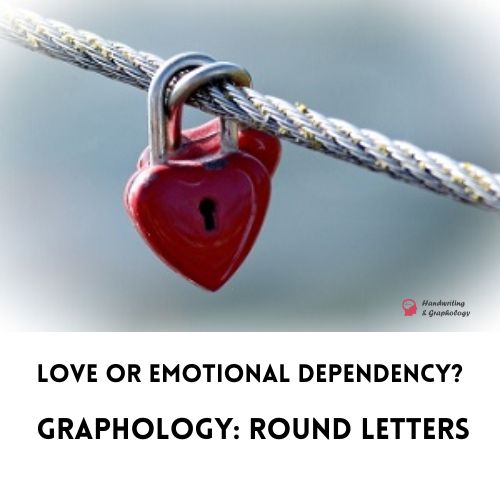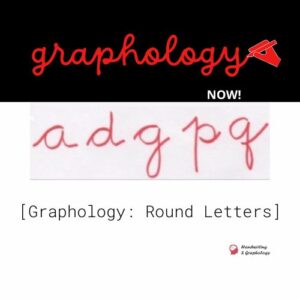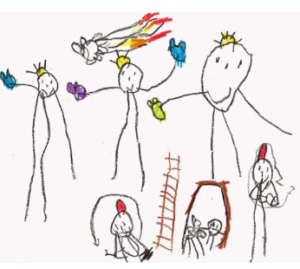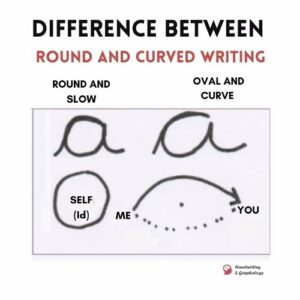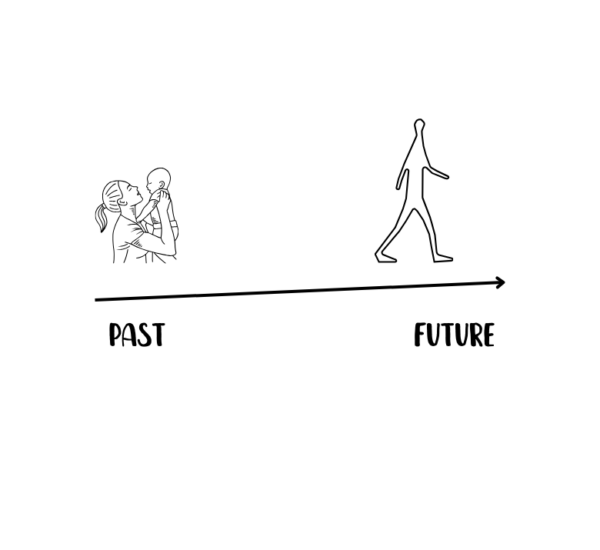Hi friends! Have you ever wondered how emotional dependency relates to round letters? Round writing is characterized by its circular shape, forming what are called ovals. It is also part of some letters such as “d”, “g”, “q”, and occasionally a round shape is given to “n”, “m”, “u”.
Round letters are clearly noticed when analyzing the middle zone of a writing. For those who need to familiarize themselves with the subject, we invite you to read the Basic Graphology article where we present a very simple introduction to handwriting analysis. This includes the zones of writing, the parts of the letters, and what each one symbolizes.
Interpreting the writing as an integrated “whole”, as a “Gestalt”. This German term means “the whole”. Gestalt graphology analyzes the text as a photograph or a painting. When we look at a photo, we observe the entire image and do not focus on particular elements.
Graphology of Round Letters. It’s Meaning
In round letters, the shape and the ovals “closure” are particularly analyzed. Whether they are round, angular, flattened or other shapes, and the “closure” if they are open or closed. And if they have any distinctive detail that sets them apart or catches attention.
The ovals are the reference for the middle zone of the writing. They symbolically represents the ego´s writer and their affectivity.
What is Emotional Dependency?
Dependency is the lack of autonomy. It is a symptom of immaturity that characterizes individuals who need others satisfy them. Dependence can be economic, labor, professional, or emotional. The emotionally dependent person needs to feel appreciation, support, or the presence of others.
What is Autonomy
Autonomy means “governing oneself”. Is the ability to be governed by the laws dictated by one’s own conscience. To have emotionally become independent.
It is almost impossible to be an autonomous person when the approval of another is needed to act in life. A weak “self” loses its own identity and the awareness that it is different from the other. There are many emotionally dependent individuals on their partner. They mimic to such an extent that they lose their own identity, becoming another person without realizing it. They change everything to please that other person so that the other person does not leave. They modify the affective self or the set of self-referential information that identifies and differentiates them from others.
Autonomy vs dependency
In adult human beings, emotional dependency generates a degree of symbiosis in order to obtain constant approval and acceptance. Protection is requested as if they were a child. Although this situation may be transitory, it is a pattern in the way of life that repeats throughout existence and in all established relationships with different people.
There are many human beings who behave like children. Unable to BE. Those who suffer from emotional dependency cannot conceive of life without their romantic partner and fear being alone. They usually relate to dominant, narcissistic people who cause anything from psychological abuse to submission and physical abuse. People affected by emotional dependency sometimes recognize that they suffer from contempt but cannot free themselves and even apologize to avoid upsetting their partner or to prevent abandonment.
Relationship between Round Letters and Emotional Dependency
What does writing in round letters mean?
P. Foglia in his work “Grafología General” quotes Solange Pellat: “All egocentric, and enveloping movements are towards the Self.”
The Monigote: Oral Stage
Round letters are related to the first stage of psychosexual development: the oral stage. The first representation of the “self” that the child makes is a circle to which he adds hands, feet, eyes, mouth: it is called in spanish the “monigote.” During the evolution, the child discovers the external world through the moutha and the mother’s breast. It is called the oral stage and finds pleasure in sucking, biting. According to how this stage is overcome, the character that person acquires will be determined. S. Freud explains in his theory that individuals who remain “fixed” in the oral stage will have infantile characteristics of emotional dependency. Psychoanalytic theory speaks of fixations on the different stages of psychosexual development that are reflected in the subject’s handwriting.
What are the fixations in emotional development stages?
You should know that not all stages of development are always traversed and overcome with the same ease. Sometimes, some people are permanently delayed in those first stages. When the needs of the child during the first stage or oral stage are not satisfied and are repressed or there are events that leave traces, it marks particular traits in their personality. Fixation is the exaggerated attachment to people or objects that leads to a delay in the emotional development of the individual.
Libido is an energy that leads us to the pursuit of pleasure. When the libido stops at certain erogenous zones, it is called fixation. When the subject stops at stages of development or forms of satisfaction experienced in the past, their evolution and development are impeded. This libidinal energy that has been fixed is repressed, giving rise to regression. For Freud, fixations can occur due to specific events such as trauma, family influences, or a certain inability of the subject to abandon a stage in which they found satisfaction. It may be due to a lack of confidence that the new stage will bring other sources of pleasure or satisfaction.
Signs of Emotional Dependency in Handwriting
The emotional dependence that persists in adult life causing difficulties in establishing new bonds is reflected in the writing. The round letters show emotional dependency in those who have difficulties in making decisions. The person, instead of relying on their own initiatives when facing situations, demands as if they were a child. They are very possessive, submissive beings and need the approval of others.
The round letters are not only observed in subjects who satisfy their existential emptiness with “gastronomic pleasures” or vices such as alcohol and tobacco. It also manifests itself in the need to feel recognized, flattered and socially important. Emotional dependency is evidenced in writing as passive or active depending on when fixation occurred. In the first oral phase (sucking phase) or in the second oral phase (sadistic or cannibalistic phase). In the cases in which the text corresponds to subjects of an active oral nature, round letters “coexist” with aggressive features (such as thrown endings, steely, disproportion).
Need for Acceptance and Attached Letters
On the other hand, when we are dealing with personalities of a passive oral nature, we will find adjoining letters, little space between words, low underworld.
This is evident in those people who need the recognition of others. They crave to be treated like children, require acceptance from others, and are extremely sensitive subjects. In general, they repress aggressiveness and find it difficult to express what they dislike, either due to fear of rejection or need for acceptance.
Round letters: Positive side
The round letters express stability of mind in the presence of unforeseen events. They show good development of perception that favors memory, a tendency to low emotionality, pay attention to image and appearances.
They reflect the ability to harmonize the useful with the pleasant and their own interests with those of others, avoiding conflicts. Disposition to find the common benefit in associations. The subject avoids risks that would expose him to losing his standard of living.
Round Letters and Temperament
According to Augusto Vels in the “Dictionary of Graphology and Related Psychological Terms” he describes that the round letters associated with a slow rhythm are linked to the lymphatic temperament. They show passive adaptability, they are sociable personalities but not very demonstrative, restful, calm and do not show enthusiasm or ambition.
There are other graphic variables that confirm aspects of the linking modality of the writer.
The dependency according to Vels is reflected in: Very inclined writing, low (capital letters and “t” bars), calligraphic writing, careful, orderly, descending, grouped (separate capital letters); delayed, paused or slow, vacant, indecisive. Emotional dependence is analyzed in the treatment of ovals and also in the spacing between letters and between words.
What are Attached Letters?
According to A, Vels in “Graphology from A to Z“, “the attached ones affect the spacing between letters, causing adhesions or hooks between letter and letter, in some cases the letters are mounted or superimposed on each other, without necessarily being a tight writing since the width of the letters can be normal or even greater.
This sign is characteristic of adolescence, it is linked to the regression of movements that imposes a brake by reservation, mistrust. It indicates a symbiotic tendency, a tendency to orality, affective dependence, even economic parasitism. This is reinforced if the writing is round, soft and wide”.
Difference between Round letters and rounded writing
There is a difference between round letters, rounded script and curvy script. Vels describes a beautiful symbolic comparison between the round and rounded letters with the movements of the planet earth (rotation and translation). The rotation movement is of the earth on its axis, on itself, it does not go forward but goes backwards, it returns to the beginning as in the round letters. Unlike the movement of translation, which is “oval”, supposes displacement and advance from the I to the You, or towards the object.
The round letters carry out a movement around itself, while in the rounded writing there is a progressive forward movement that goes from the “I towards the others”.
From this symbolic comparison, meanings can be inferred around the orientation of desires and affective bonding:
1. The “egocentric” around the body itself, its needs in round writing.
2. The direction to the “object” in round or oval writing.
The Rounded Handwriting
Rounded writing is more agile and active than round writing. It implies movement towards the “love object”. In childhood this love object is represented by the mother or the father. In adulthood by a person of the opposite sex (once the Oedipus complex has been overcome). This progressive movement also translates to the work and professional fields. The subject is mobilized towards goals of achievement in the outside world expressing desires for communication, participation and reception.
How do you analyze rounded writing from the positive side?
It is framed as a progressive handwriting that transmits the adaptation of the subject without difficulties or impediments and implies good health. The subject manages to satisfy his needs without clashes between what he wants and the possibilities that reality presents him. This writing is characterized by presenting a rhythm that is preserved within the “methodical inequality” (Moretti).
How to Interprete Rounded Letters
Pleasant character, sympathy, empathy, benevolence, imagination, taste for aesthetics and art. Rounded writing when there is good graphic dynamism “methodical inequality”, is associated with optimism, joy of living, with grace, seduction.
According to Augusto Vels “Round writing is more introjective than extrajective”. “The rounded script is more extrajective than introjective.”
Graphology: Curved Writing
Differences between Round Letters and Curved Writing
Curvilinear writing is called writing whose normal angles in the letters adopt a curvilinear shape. The curve symbolizes adaptation, communication, affability, empathy, complacency. The curve analyzed from the movement is characterized by an easy line that slides and flows spontaneously towards the “object”. He “moves” towards others out of a need for tenderness, for communication, for affective identification, in search of affinities. Adaptation is a sign of harmony and psychic balance.
The Dark Side of the Curve
The curve can also be selfish and respond to a need of the subject to feel the center of all interest and attention. Giving rise to selfishness, self-centeredness, narcissism. Two types of curve are distinguished:
- Round and slow curve.
- Oval curve.
The curved writing reflects: union, love, pleasure, affability, empathy, although the intention may be hoarding and selfish.
Here ends this article on Round Letters and Emotional Dependence. Stay on this website to learn more about Graphology. Share it with your friends if you find it useful.
Source: A. Vels in “Graphology from A to Z”. Augusto Vels, “Dictionary of Graphology and related Psychological terms”, P. Foglia, “General Graphology Vol II”.
Principio del formulario

